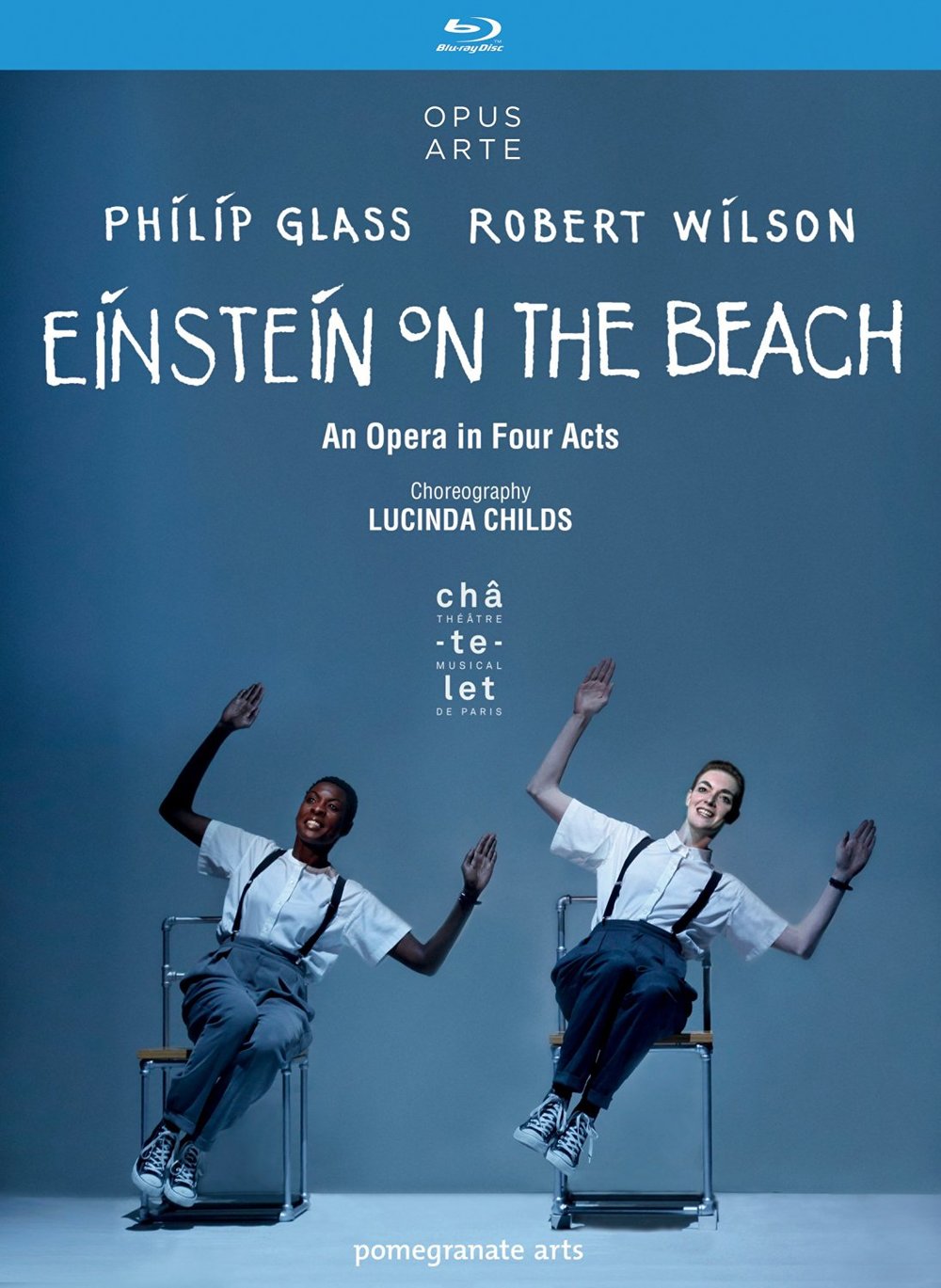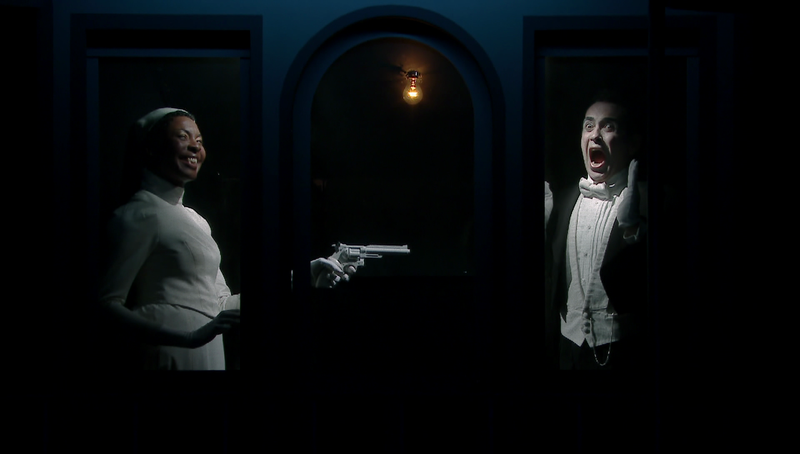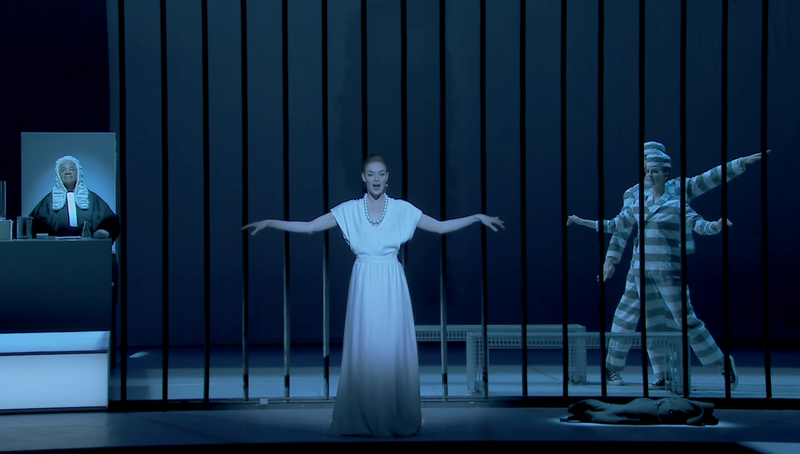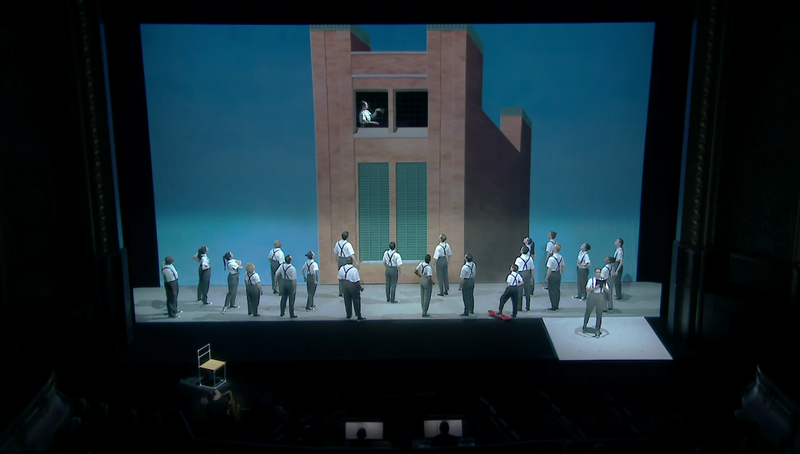

Einstein on the Beach performance art piece performed 2014 at the Théâtre du Châtelet in Paris. Music by Philip Glass. Directed for stage by Robert Wilson. Choreography by Lucinda Childs. Random number and solfège lyrics called for by the composer. Actual texts used were from Christopher Knowles (a neurologically impaired teenager and poet whom Wilson helped as special ed teacher), Samuel M. Johnson (an elderly black performer who was a friend of Wilson), and choreographer Lucinda Childs (who contributed the monologue "I was in this prematurely air-conditioned supermarket").
Main performers (alphabetical order) are Helga Davis (Helga), Kate Moran (Kate), Jasper Newell (Boy), Antoine Silverman (Albert Einstein), and Charles Williams (Mr. Johnson, who in turn appears as the Judge and as Bus Driver). Music Director Michael Riesman conducts the Philip Glass Ensemble comprised of Lisa Bielawa, David Crowell, Dan Dryden, Jon Gibson, Mick Rossi, and Andrew Sterman. Dancers from the Lucinda Childs Dance Company are Ty Boomershine (répétiteur), Katie Dorn, Katherine Helen Fisher, Sarah Hillmon, Anne Lewis, Sharon Milanese (court reporter), Patrick John O'Neill, Matt Pardo, Lonnie Poupard, Jr., Caitlin Scranton, John Sorensen-Jolink, and Shakirah Stewart (court reporter). Members of the chorus are Philip Anderson, Joe Damon Chappel, Hai-Ting Chinn, Tomás Cruz, Michèle A. Eaton, John Kawa, Lindsay Kesselman, Kate Maroney, Solange Merdinian, Gregory R. Purnhagen, Melanie Russell, and Jason Charles Walker. Co-director Ann-Christin Rommen; Directing Associate Charlie Otte; lighting by Urs Schöenbaum and John Torres; sound by Dan Dryden; costumes by Carlos Soto; hair and make-up by Luc Verschueren and Campbell Young Associates. Directed for TV by Don Kent. Produced by Pomegranate Arts, Inc; Executive Producer Linda Brumbach; Associate Producer/General Manager Kalib Kilkenny; Associate Producer Alisa E. Regas; Production Manager Marc Warren; Associate General Manager Linsey Bostwick. Sung and spoken in English. Released 2016, title has 2 Blu-ray discs with 5.1 dts-HD Master Audio surround sound. Grade: A+ with ‽ designation.
Einstein on the Beach ("Einstein") consists of surreal reflections on the most realistic life ever led. It premiered in 1976 and became an instant cult classic.
Einstein is a difficult work to produce as it calls for a large investment in unusual talent, sets, and lighting to perform 4 1/2 to 5 hours of difficult music and stagecraft in an "authentic" and unified manner. In the screenshot next below you see (left to right) Philip Glass (then age 77), Lucinda Childs (then age 74), and Robert Wilson (then age 73), all taking bows in 2014. It isn't hard to imagine that Einstein may never again be produced under any of the 3 originators. Subject title is the first and only attempt to date to record the entirety of the opera on video. So this Opus Arte project could become the definitive record of Einstein for all time.
Einstein has no intermission. Members of the audience were expected to come and go at will, but contemporary reports of actual productions suggest that few took a break. In your HT, feel free to stop anytime to fetch a beer. The spoken and sung words in this work are mostly nonsensical; the few passages in complete and understandable sentences are delivered very clearly. So Opus Arte elected not to spend money on subtitles. Still, we provide our libretto with all the sensible text in the order it appears in the Opus Arte recording.
Einstein is best defined by what it lacks; while it has composed sheet music played by a musical ensemble, vocal and instrumental soloists, elaborate stage design, and set pieces, there is nothing resembling a plot or narrative. It instead relies on emotional reactions to the dream-like proceedings to propel the opera forward. The only through lines are the music itself, which consists of cycles of repeated minimal arrangements, and the five main performers credited above.
Musically, the opera again differs itself by eschewing the traditional orchestra in favor of the Philip Glass Ensemble. The instruments include amplified flutes, saxophones, bass clarinet, organ, keyboards, and synthesizer bass. The chorus alternates between singing random numbers and solfège syllables. The style is Glass' famous minimalist approach, with pulsing rhythms repeated and slowly mutated with each cycle of the music. One might think this minimalist style might grate or grow tiresome. This isn't the case; the music has enough variation that it remains potent until the last bar.
There are 14 segments in this opera: 9 Scenes plus 5 Knee Plays (explained below). We have provided an outline of the 14 segments with their Opus Arte time stamps. (Trying to keep track of the 4 Acts is more confusing than helpful.) Because Einstein is a surreal opera, it takes extra effort to master it. If you keep our tailor-made libretto and outline of the opera handy, you will find it much easier to learn this long and mysterious work.
Now meet below Kate Moran (on your left) and Helga Davis playing themselves. They are going to have an amazing adventure with Albert and his beach. Here they perform Knee Play 1. The Knee Plays are short pieces which connect (as the knee connects femur to tibia) the major scenes in a typical Robert Wilson production.
Kate recites a text from Christopher Knowles with comments about sailboats, which Albert loved as a hobby. Helga delivers random numbers, and Albert, of course, was also pretty good with numbers. By the time Knee Play 1 is over, you will understand what we mean by "dream-like proceedings", which mostly suggest elements you can associate with Albert. Thankfully, these elements do come up roughly in chronological order. You see Kate and Helga are dressed as Albert in his trademark cheap, but crisp, white shirt and ill-fitted trousers with suspenders. (You will see this costume often.) You will also note that there are a fair number of "persons of color" employed in this show. This is consistent with Albert's respect for all peoples. After he settled in the US, he joined the NAACP at a time when that was quite a statement:
In the next screenshot below we have moved into Scene 1 of Act 1, called Train. Every budding physicist starts off in about the 5th grade reading simplified books about Einstein's famous thought experiments, which often involved imaginary trains moving at different speeds in relation to each other. You will notice a strange bar of white that appears to come out of the smokestack. This white bar is a Robert Wilson visual trope that you will see repeatedly throughout this show. Later Albert will sit in the empty chair:
Next we see a close-up of the boy on the crane. He is, of course, young Albert wondering:
The character below is Crazy Eddie frantically marking up something on a invisible board. The originators of Einstein were obscure members of the New York high-art avant-garde who valued silly humor just as Albert did. Crazy Eddie was the owner of NY discount stores that used wildly over-the-top carpet-bombing ads (radio and TV) to sell consumer electronics at "insanely low" prices. Crazy Eddie reminds us that many people thought Albert was crazy for his theories about the mutability of time and the like. (The Crazy Eddie stores eventually went bankrupt.):
And yes, the title of this show is Einstein on the Beach (not Einstein on the Train). We know we are at the beach because there is a conch shell lying on the ground. You don't find a conch shell at the railroad yard---you find it at the beach!
And you know why you like to listen to the shell: even though it's definitely making no noise at all, you can hear the entire universe inside. Albert, you hear, was more interested in imagination than in facts. Of course, he knew the facts that others had discovered. But Albert didn't let the facts tie him down. He hauled them aloft with his imagination:
In 1905, Einstein published 4 papers that contributed greatly to the basis for modern physics: his paper on the photoelectric effect helped solidify the idea that light can act as both a wave and a particle; his Brownian Motion paper helped to prove the existence of the atom; the paper on special relativity shed light on the nature of movement, electromagnetism, and light itself; and the final paper on mass-energy equivalence is where we get the famous "E=mc2" equation. After the "miracle year" of 1905, physicists stayed busy for a long time trying to prove Einstein wrong. So that brings us to the Trial (Bed) scene next below. We see Wilson's bar of light high above the court bench and also on the edge of a "bed" on the floor of the courtroom:
Now Albert is sitting on the chair playing the violin, his most famous hobby:
And here's a near-shot of the chorus serving as jury and the stenographers played by Shakirah Stewart and Sharon Milanese, members of the Lucinda Childs Dance Company:
And below is a near-shot of spectators at the trial, including a Native American woman:
The Native American woman refers to Albert's visit with Hopi Indians who (perhaps by myth) gave him a peace pipe in honor of his pacifism and "adopted" him as the "The Great Relative." A different explanation of his picture would be that Albert and his wife were simply clowning a bit at a Grand Canyon tourist trap:
The senior judge at the trial is Mr. Johnson, played by Charles Wilson. The junior judge is played by Jasper Newell. Note the bibs worn by the judges, which are more Robert Wilson bars of white:
Helga is put to work as prosecutor, who delivers a diatribe complaining of Mr. Bojangles and his baggy pants. Mr. Bojangles was a character in a 1970 hit popular song in the US: I knew a man, Bojangles, and he danced for you / In worn out shoes / Silver hair, a ragged shirt and baggy pants / The old soft shoe. Bojangles danced for tips when he could, but mostly he danced in jail to amuse fellow prisoners:
The lawyer arrives late:
And Kate is sworn in as a witness!
The clock on the wall runs backwards. The compass can't figure out which direction it's pointing. A gyroscope crosses the stage. But suddenly it's time for a break:
And after much suspense, you learn that each lunch bag contains a cup of coffee:
And the trial concludes with an eloquent but ludicrous oration from the bench asking if the statement "All men are created equal" also applies to women:
Next below is shot of Knee Play 2, when the ladies break character and say, "Bern. Switzerland. 1905." This refers, of course, to the miracle year. These 8 syllables comprise the only spoken or sung utterance in the opera that makes objective sense---everything else is surreal:
Act 2 begins with Lucinda Child's Field 1 (Space Machine) dance piece. It's a calm and classical presentation of various orderly patterns of movement (which might remind you of the work today of Mark Morris). Towards the end of the dance a space ship (which if viewed straight from the side would look like another Robert Wilson bar of light) crosses the stage. Albert concluded that light has both particle and wave aspects. Some critics have suggested that the emphasis in Act 1 on reciting numbers represents the particle feature of light. To them the Field 1 (Space Machine) dance represents the wave aspect of light:
Later in Act 2 we move from the engine of the train to the caboose. The one aspect of Albert's life which was not much different from the experiences of ordinary men was his problems with women. The caboose scene seems to start off depicting a blissful romance:
Oh dear, the gent is checking his watch. Is time causing problems again?
Now we are back in the court room at the beginning of Act 3. Albert was, of course, prominent among his scientific peers. But his fame and celebrity with the public was unique in all history. There were many reasons for his popularity. But above all else the public got the irony that this gentle pacifist was also the one who wrote that letter to President Roosevelt which resulted in the atomic bomb. So now Albert is being tried by public opinion and the stakes are higher than before: jail!
Kate is moved to the bed to testify, but all she can think of is her recent visit to a prematurely air-conditioned supermarket:
The stenographers go crazy:
And suddenly Kate is transformed to Patty Hurst in her care-free days:
But who was kidnapped and turned (or brain-washed, or forced) by terrorists to take part in violent acts. Patty's story was white-hot and not concluded when Einstein was premiered, so it formed a parallel to Albert's story of innocence and remorse. (Patty's story still isn't completely over---did you know that she was prosecuted by none other than Robert S. Mueller III?).
But soon Kate returns as her old self to the witness stand to recite the Christopher Knowles poem "I feel the earth move" which refers to "Einstein on the beach" and is the actual source for the title of the opera :
At the end of Act 3 comes the Field 2 (Space Machine) dance:
Next below a shot from Knee Play 4:
Which includes the most iconic of Albert's poses:
Act 4 is the Building scene with a surreal image that reminds one of Giorgio de Chirico or Rene Magritte:
Glass cuts loose with a magnificent jazz saxophone solo:
Various characters (here from left to right, the Boy, a chorus member, and 2 dancers) come on stage before the building and adopt typical Robert Wilson poses:
Followed by an unusual twist where the actors turn their backs to the audience (except for the reading man, who always ignores all that is taking place around him to concentrate on his interesting book):
The emotional climax of the opera is the famous Bed scene where a horizontal bar of light slowly goes vertical and disappears into the fly space:
The Bed music (the opera's only aria) is sung without words and accompanies the apotheosis of the bed. It is performed here by mezzo Hia-Ting Chinn:
The final scene in Act 4 is Space Machine (Interior), which would appear to be inspired by the movie Metropolis:
Elevator A doesn't elevate, but conveys:
Some of the Philip Glass Ensemble have fled the pit to ride on the Space Machine:
Kate and Helga seem terrified:
And for good reason! The opera ends with an atomic bomb attack! This should remind you of Albert's grandest joke: "I know not with what weapons World War III will be fought, but World War IV will be fought with sticks and stones."
Wilson provides a happy ending. In Knee Play 5, a bus driver recites, from the pen of Samuel M. Johnson, "a familiar story, a story that is so very, very old, and yet it is so new. It is the old, old story of love."
This recording received the 2017 Annual Diapson d'Or Award in the opera category. Pwyll ap Siôn, writing in the January 2017 Gramophone (page 85), expresses controlled admiration for this recording of "an opera unlike any other." He suggests that if you're a fan of Glass or contemporary opera, this is "as close to a definitive version of the opera as you're likely to get."
Glass and Wilson have always been quick to state that Einstein on the Beach isn't about anything more than Einstein himself, and that the audience shouldn't get too wrapped up in trying to decipher all the cryptic imagery and scenery. Without a narrative, all the audience can get from the opera are emotional responses.
Still, there are themes and motifs that seem to point to what the opera is really about: the contradiction between a pacifist whose ideas whose ideas led to the horrors of atomic warfare. The beginning of the opera roughly corresponds to that of the man of ideas with young Einstein marveling at light and an older Einstein listening to the sound of the universe through a conch. This is followed by the first Trial, where Albert's scientific notions are put to the test. The trial ends with vindication (in the same way women should overtake men, Albert's new theories would overtake the old). The next Train scene introduces the more sinister element of the threat of violence. In the second trial, half the courtroom is converted to a prison. Now the trial is about the use of the new science, echoed by the Patty Hearst dilemma. The Space Machine (Interior) scene updates the horrific aspects of the industrial revolution to the even greater potential horrors of nuclear fission. But the opera doesn't end with an atomic explosion --- it ends with a rumination on love.
There might not be any easy answers to the surreal challenges of this opera, but it is profoundly fascinating all the same. The PQ and SQ are excellent. We did a Wonk Worksheet on Disc 1. Don Kent's video pace of 7.5 seconds per clip was faster than we thought, but it is slower than a typical DVD, which is good. 51% of Kent's images show the whole bodies of the persons on stage. He used a lot of close-ups, but this was necessary for a show where so much depends on the emergence of small but important details. We conclude this is an excellent recording of a unique and exemplary performance that deserves an A+.
Here's a short official clip from Opus Arte with a few words on equal rights for women:
And here's a bootleg clip where the focus is on baggy pants:
OR


















































